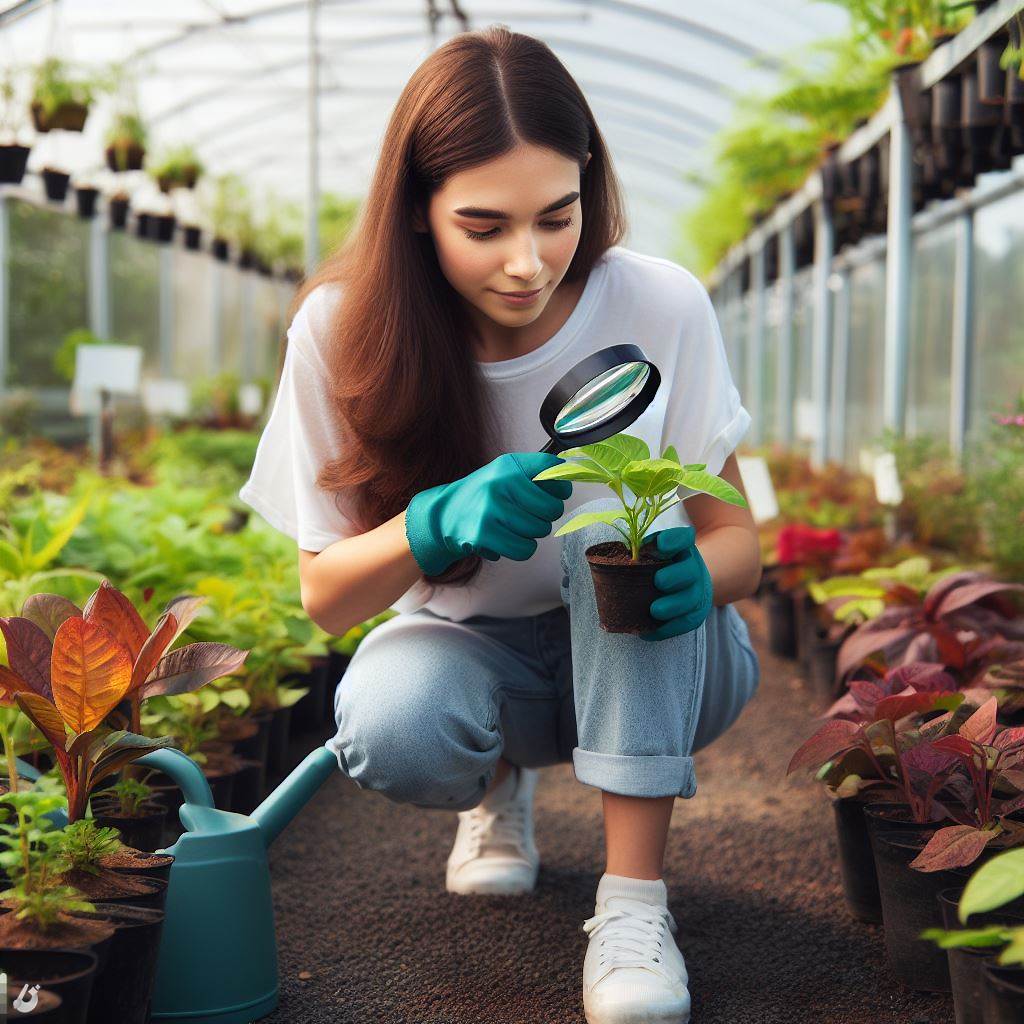Introduction
Growing herbs and spices in a flavor garden brings a delightful and aromatic addition to your home.
Having fresh herbs and spices at your fingertips offers numerous benefits, such as enhanced flavors in your cooking and the convenience of saving money by not buying packaged herbs.
Imagine the joy of plucking a sprig of fresh rosemary or basil from your own garden to add to your favorite dish.
The burst of fragrance and flavor will elevate your culinary experience to new heights.
Plus, it’s a rewarding and therapeutic activity to tend to your plants and watch them thrive.
Whether you have a large backyard or a tiny balcony, there are various ways to create a flavor garden that suits your space and preferences.
From classic favorites like parsley, thyme, and oregano to exotic spices like turmeric and cardamom, the options are endless.
The vibrant colors and scents of these herbs and spices also add aesthetic appeal to your home and can transform a dull corner into a lively and inviting space.
So, roll up your sleeves, get your gardening tools ready, and prepare to embark on a journey of flavor, freshness, and satisfaction as you grow your very own flavor garden.
Get ready to elevate your culinary creations and impress your family and friends with the vibrant flavors of freshly harvested herbs and spices.
Importance of Herbs and Spices
Herbs and spices play a vital role in dish flavor, providing tastes that other ingredients can’t match.
Fresh varieties elevate taste and aroma.
They transform basic dishes into culinary marvels, impressing discerning palates.
Essential for balanced, flavorful dishes, they add depth and complexity, enhancing various cuisines.
The right combination makes a dish memorable and enjoyable, turning the ordinary into the extraordinary.
With endless possibilities for experimentation, they unleash creativity for chefs and home cooks alike.
Used for centuries, they boast medicinal properties, boosting digestion, reducing inflammation, and offering antioxidants.
Transform Your Agribusiness
Unlock your farm's potential with expert advice tailored to your needs. Get actionable steps that drive real results.
Get StartedThey replace or reduce salt and unhealthy condiments, adding flavor without excessive sodium or additives.
A cost-effective way to enhance meals, they make inexpensive ingredients more enjoyable.
Easily grown at home, a flavor garden ensures a year-round, high-quality supply.
Growing your own provides control over freshness and purity, maximizing taste contribution to dishes.
In short, essential in cooking, herbs and spices add flavor, depth, and health benefits.
Read: Agroforestry: Combining Trees and Crops Wisely
Choosing the Right Herbs and Spices
List of common herbs and spices that are easy to grow
Choosing the right herbs and spices for your flavor garden is essential in creating a vibrant and aromatic space.
Here is a list of common herbs and spices that are easy to grow
- Basil
- Mint
- Thyme
- Rosemary
- Cilantro
- Parsley
- Oregano
- Sage
- Dill
- Chives
The importance of selecting herbs and spices that suit your climate and gardening conditions
It is important to select herbs and spices that suit your climate and gardening conditions. Different varieties thrive in different environments, such as
- Basil prefers warm temperatures and well-drained soil.
- Mint thrives in moist soil and shade.
- Rosemary prefers dry conditions and well-drained soil.
- Cilantro grows best in cool weather and partial shade.
- Parsley needs moist soil and plenty of sunlight.
- Oregano requires full sun and well-drained soil.
- Sage prefers sunny and dry conditions.
- Dill thrives in warm weather and well-drained soil.
- Chives grow well in moist soil and full sun.
The versatility of different herbs and spices and their various uses in cooking
The versatility of different herbs and spices is a fantastic addition to any home cooking.
Here are their various uses in the culinary world
- Basil adds a fresh and aromatic flavor to pasta, salads, and sauces.
- Mint is perfect for flavoring drinks, desserts, and savory dishes like lamb or salads.
- Thyme is great for seasoning meats, soups, stews, and roasted vegetables.
- Rosemary enhances the flavor of roasted meats, potatoes, and bread.
- Cilantro adds a bright and citrusy note to salsas, curries, and guacamole.
- Parsley is a versatile herb that can be used as a garnish or added to soups, stews, and sauces.
- Oregano is commonly used in Italian and Mediterranean dishes, such as pizza, pasta sauces, and salads.
- Sage pairs well with poultry and is often used in stuffing, sauces, and as a seasoning for roasted vegetables.
- Dill is perfect for flavoring fish, pickles, soups, and salads.
- Chives provide a mild onion flavor and can be used in salads, dips, soups, and as a garnish.
By growing your own herbs and spices, you have the power to enhance your favorite dishes and experiment with different flavors.
Take advantage of this opportunity to create a flavorful garden that suits your taste preferences and gardening conditions.
Happy growing!
Read: Vertical Gardening: Maximize Your Yield

Setting Up Your Flavor Garden
Selecting the right location
- Choose a spot that receives at least six hours of sunlight every day.
- Avoid areas with strong winds or excessive shade.
- Consider proximity to your kitchen for easy access.
Different methods of gardening
In-ground gardening
- Requires proper soil preparation and good drainage.
- Allows herbs and spices to grow freely and spread.
- Maintaining weed control is important.
Raised beds
- Provide better drainage compared to in-ground gardening.
- Allow better control of soil quality and pest management.
- Make it easier to reach and maintain your plants.
Pots and containers
- Perfect for small spaces or apartment dwellers.
- Ensure adequate drainage and choose the right-sized pots for each plant.
- Allow for mobility, so you can move your plants to follow the sun.
The importance of proper sunlight, soil, and watering
Sunlight
- Most herbs and spices require full sun for optimal growth and flavor.
- Ensure your garden receives the recommended amount of sunlight each day.
- Use shading or plant positioning to protect against intense midday sun.
Soil
- Choose well-draining soil with good organic matter content.
- Amend heavy clay soils with sand or organic matter to improve drainage.
- Frequent soil testing can help you adjust pH levels for specific herbs and spices.
Watering
- Adequate watering is crucial for herb and spice cultivation.
- Most herbs prefer slightly drier conditions, while spices may require more moisture.
- Water deeply and allow the soil to dry out slightly between waterings.
Read: Urban Farming: Growing Food in City Spaces
Planting and Caring for Herbs and Spices
Step-by-Step Instructions
- Select an appropriate location in your garden that receives at least 6-8 hours of sunlight every day.
- Prepare the soil by removing any weeds and adding organic matter such as compost or well-rotted manure.
- Dig small holes or trenches according to the herb’s planting instructions, ensuring adequate space for growth.
- Gently remove the herb or spice plant from its nursery pot, taking care not to disturb the root system.
- Place the plant in the prepared hole, making sure it is planted at the same depth as it was originally.
- Backfill the hole with soil, firming it gently around the roots to eliminate any air pockets.
- Water the newly planted herb or spice thoroughly, providing enough moisture to saturate the entire root zone.
- Add a layer of organic mulch around the plant, maintaining a 2-inch distance from the stem.
Growth and Germination Requirements
- Herbs like basil and oregano prefer well-drained soil, while mint and coriander thrive in moist conditions.
- Most herbs and spices require a pH level between 6 and 7 for optimal growth and nutrient absorption.
- Some herbs, including rosemary and thyme, benefit from a more alkaline soil with a pH of 7.5 to 8.5.
- Ensure proper air circulation around the plants to prevent moisture-related diseases, such as powdery mildew.
- Many herbs and spices germinate best at temperatures between 65°F and 75°F (18°C to 24°C).
- Some seeds, like dill and coriander, need to be sown directly into the garden, while others benefit from indoor starts.
- Most herbs and spices require regular watering to keep the soil consistently moist but not waterlogged.
- Monitor the plants regularly for any signs of pests or diseases, such as aphids or fungal infections.
Maintenance, Pruning, and Fertilizing
- Regularly pinch or prune the tips of herbs like basil and mint to encourage bushier growth.
- Prune herbs with woody stems, such as rosemary and thyme, in early spring to promote vigorous new growth.
- Remove any dead or yellowing leaves to maintain the overall health and appearance of the plants.
- Fertilize herbs and spices with a balanced organic fertilizer once a month during the growing season.
- Alternatively, use a slow-release granular fertilizer according to the package instructions.
- Keep in mind that some herbs, like cilantro and dill, have a short lifespan and should be replanted regularly.
- When harvesting herbs, always leave at least two-thirds of the plant intact to ensure continuous growth.
- Regularly check for signs of overcrowding and divide the plants if necessary to maintain optimal spacing.
By following these step-by-step instructions, understanding the germination requirements, and implementing proper maintenance techniques, you can easily grow a flourishing herb and spice garden in your own backyard.
Enjoy the flavors and aromas these plants bring to your dishes while basking in the satisfaction of nurturing your flavor garden.
Read: Permaculture Basics: Nature’s Way in Agriculture
Harvesting and Storing Herbs and Spices
Harvest herbs and spices at peak flavor for optimal potency.
Cut leafy herbs before flowering for maximum taste.
Wait for seed ripening before harvesting.
Use sharp shears above leaf nodes for clean cuts.
Harvest roots and bulbs in fall after foliage dies.
Clean harvested herbs, removing dirt and insects.
Preserve with drying, a common method.
Air-dry low-moisture herbs like oregano, thyme, and rosemary.
Showcase Your Farming Business
Publish your professional farming services profile on our blog for a one-time fee of $200 and reach a dedicated audience of farmers and agribusiness owners.
Publish Your ProfileBundle stems, hang upside down in a warm, well-ventilated area.
Dry away from sunlight to retain flavor and color.
Use a dehydrator or oven on low heat.
Regularly check for mold or decay.
Freeze herbs after washing and patting dry.
Use ice cube trays for better flavor retention.
Submerge in oil to prevent spoilage.
Label frozen herbs with preservation date.
Store dried or frozen herbs in dark glass jars.
Avoid plastic containers to prevent flavor impact.
Keep in a cool, dry place away from light and heat.
Organize alphabetically or by categories for accessibility.
Check stored herbs for moisture or deterioration.
Properly stored, dried herbs last up to a year, spices for two.
Note that potency diminishes over time.
Use double the amount of dried herbs in recipes.
Enjoy your homegrown flavors in favorite dishes!
Using Fresh Herbs and Spices in Cooking
Growing your own herbs and spices not only adds flavor to your dishes but also brings a touch of freshness and vibrancy to your cooking.
In this blog section, we will explore the advantages of using fresh herbs and spices over their dried alternatives, provide recipe ideas for different types of dishes, and share tips on combining herbs and spices to create unique flavor profiles.
Advantages of Using Fresh Herbs and Spices
- Enhanced Flavor: Fresh herbs and spices have a more potent aroma and flavor compared to their dried counterparts.
The oils and volatile compounds present in fresh herbs and spices are at their peak, delivering a burst of taste to your dishes. - Nutritional Value: Fresh herbs and spices are packed with essential vitamins, minerals, and antioxidants.
Using them in your cooking not only adds flavor but also promotes a healthier diet. - Versatility: Growing your own herbs and spices allows you to experiment with a wide range of flavors.
From delicate and mild to bold and robust, you can customize your dishes and create different taste profiles according to your preferences. - Cost-Effective: Buying fresh herbs and spices can be more economical in the long run.
When you have your own herb garden, you can pick as much as you need, reducing waste and saving money compared to purchasing pre-packaged dried herbs.
Recipe Ideas and Suggestions
- Pasta Perfection: Toss freshly chopped basil and parsley with cooked pasta, cherry tomatoes, garlic, olive oil, and parmesan cheese for a simple yet flavorful herb-infused dish.
- Dynamic Dressings: Whip up a tangy vinaigrette by combining fresh dill, lemon juice, olive oil, garlic, and a pinch of salt.
Drizzle it over salads or use it as a marinade for grilled chicken or fish. - Exquisite Marinades: Blend together fresh rosemary, thyme, minced garlic, lemon zest, and olive oil.
Marinate your choice of meat or vegetables for a few hours before grilling or roasting for an aromatic and juicy outcome. - Zesty Salsas: Combine diced fresh tomatoes, cilantro, jalapenos, red onions, lime juice, and a hint of cumin for a vibrant and flavorful salsa that pairs perfectly with tortilla chips or grilled meats.
- Flavorful Infusions: Create herb-infused oils or vinegars by placing fresh herbs such as basil, thyme, or rosemary into a bottle, covering them with oil or vinegar, and letting them infuse for a week or two.
These can be used to enhance the taste in dressings or drizzled over dishes.
Tips for Combining Herbs and Spices
- Balance is Key: Experiment with different herb and spice combinations, but remember to strike a balance to avoid overpowering flavors.
Start with a smaller quantity and adjust as needed. - Complementary Pairings: Consider the flavor profiles of each herb and spice.
For example, basil and tomatoes work harmoniously together, while cumin and coriander create an earthy and aromatic combination. - Add Layers of Flavor: To create depth in your dishes, try using a combination of herbs and spices from different flavor categories, such as using both thyme and paprika in a roasted chicken dish.
- Fresh at the End: Add delicate herbs like cilantro, parsley, or basil towards the end of cooking to retain their fresh flavors.
This also adds a vibrant pop of color to your finished dish. - Trust Your Taste Buds: While recipes can provide guidance, trust your taste buds and adjust the seasoning according to your preferences.
Cooking with herbs and spices is about personalizing flavors.
Basically, growing and using fresh herbs and spices in your cooking is a delightful way to elevate your dishes.
The advantages of freshness, enhanced flavor, versatility, and cost-effectiveness make it a rewarding endeavor.
With the provided recipe ideas and tips for combining flavors, you can embark on a culinary journey, adding unique and delicious profiles to your favorite meals.
Conclusion
Growing your own flavor garden and using fresh herbs and spices in cooking have numerous benefits.
Based on the key points discussed in this blog post, it is evident that having a flavor garden allows you to have easy access to a wide range of herbs and spices.
This means you can enhance the taste and aroma of your meals, experiment with different flavors, and customize your dishes to suit your preferences.
Moreover, using fresh herbs and spices can elevate the nutritional value of your meals.
These natural ingredients contain essential oils, antioxidants, and other compounds that can promote better health.
By starting your own herb and spice garden, you can ensure that you are using the freshest and highest quality ingredients in your cooking.
Furthermore, growing your own garden is not only cost-effective but also environmentally friendly.
You can reduce your reliance on store-bought herbs and spices that may have been treated with pesticides and traveled long distances.
Lastly, having a flavor garden provides endless possibilities for creativity in the kitchen.
You can experiment with different combinations of herbs and spices to create unique flavors and signature dishes.
So, why wait? Start your own herb and spice garden today and explore the limitless possibilities of flavors in your meals.




